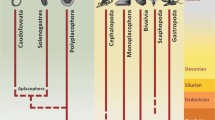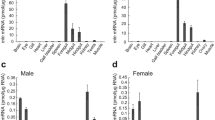Summary
Autoradiographic studies reveal a strong specific incorporation of 3H-Proline in the “white gland” in the foot of Mytilus edulis. The author could trace the radioactive secretory product from its synthesis in the basal part of the cells down to its outflow into the pedial groove where it takes part in the formation of the filament. Purified collagenase takes out radioactivity from the sections. This observation confirms the collagenous nature of the secretion.
The other foot-glands as well as the main “byssus gland” located at the base of the foot show but a very weak labelling not comparable with that of the “white gland”. This clearly evidences that the collagen occuring in the filament originates from the latter. The “white gland” may be properly called: “collagen gland”.
Control sections through different parts of the body (mantle-edge, mantle, gills) confirm that our injection technique of the precursor into the palleal margin is a suitable method for a rather quick and specific labelling of the glandular collagen.
Résumé
L'autoradiographie révèle, au niveau du pied, une incorporation massive et sélective de la 3H-Proline dans la ≪glande blanche≫ de Mytilus edulis. Cette étude a permis de suivre le processus qui mène de la synthèse de la sécrétion dans la partie basale des cellules jusqu'a son émission dans le sillon pédieux où elle participe à la formation du filament. La collagénase détruit la presque totalité du marquage, attestant ainsi la nature collagénique du produit sécrété. Les autres glandes pédieuses ainsi que la glande du byssus proprement dite, située à la base du pied, montrent une incorporation très faible, sans commune mesure avec celle de la ≪glande blanche≫. Ceci démontre de façon définitive que le collagène présent dans le filament prend naissance dans cette glande et justifie la dénomination de ≪glande du collagène≫. Des contrôles réalisés dans différentes régions (bords du manteau, manteau, branchies) montrent que l'injection du précurseur dans le bord palléal constitue une méthode satisfaisante pour marquer de façon relativement rapide et différentielle le collagène de la glande.
Similar content being viewed by others
Bibliographie
Bevelander, G., Nakahara, H.: An electron microscope study of the formation of the periostracum of Macrocallista maculata. Calc. Tiss. Res. 1, 55–67 (1967)
Carneiro, J., Leblond, C. P.: Role of the osteoblasts and odonloblasts in secreting the collagen of bone and dentin, as shown by autoradiography in mice given tritium-labeled glycine. Exp. Cell Res. 18, 291–300 (1959).
—: Suitability of collagenase treatment for the radioautographic identification of newly synthesized collagen labeled with 3H-Glycine or 3H-Proline. J. Histochem. Cytochem. 14, 334–344 (1966).
Leblond, C. P.: Elaboration of dentinal collagen in odontoblasts as shown by radioautography after injection of labeled glycine and proline. Ann. Histochim. 8, 43–50 (1963).
Mortreuil-Langlois, M.: Staining sections coated with radiographic emulsion: a nuclear fast red, indigo-carmine sequence. Stain Technol. 37, 175–177 (1962).
Pasteels, J. J.: Pinocytose et athrocytose par l'épithélium branchial de Mytilus edulis L. Z. Zellforsch. 92, 339–359 (1968).
Porter, K. R.: Cell fine structure and biosynthesis of intercellular macromolecules. Biophys. J. 4, 167–196 (1964).
Pujol, J. P.: Le complexe byssogène des Mollusques Bivalves. Histochimie comparée des sécrétions chez Mytilus edulis L. et Pinna nobilis L. Bull. Soc. Linn. Normandie 8, 308–332 (1967).
Randall, J. T., Fraser, R. D. B., Jackson, S., Martin, A. V. W., North, A. C. T.: Aspects of collagen structure. Nature (Lond.) 169, 1029–1033 (1952).
Revel, J. P.: The formation of the basement lamella in regenerating salamander limbs. In: Symp. Int. Soo. Cell Biol., ed. C. P. Leblond and K. B. Warren, vol. 4, p. 293–301. New York: Acad. Press 1965.
—, Hay, E. D.: An autoradiographic and electron microscopic study of collagen synthesis in differentiating cartilage. Z. Zellforsch. 61, 110–144 (1963).
Ross, R.: Synthesis and secretion of collagen by fibroblasts in healing wounds. In: Symp. Int. Soc. Cell Biol., ed. C. P. Leblond and K. B. Warren, vol. 4, p. 273–291. New York: Acad. Press 1965.
—, Benditt, E. P.: A quantitative radioautographic study of the utilization of proline-H3 in wounds from normal and scorbutic guinea pigs. J. Cell Biol. 15, 99–108 (1962).
Seiguer, A. C., Gonzalez Cadavid, N., Paz, M., Mancini, R. E.: Radioautographic and radiochemical analysis of postnatal collagen formation in mouse dermal skin. Ann. Histochim. 12, 363–377 (1967).
Author information
Authors and Affiliations
Additional information
Cette note fait partie d'un travail pour l'obtention d'une thèse de doctorat.
Rights and permissions
About this article
Cite this article
Pujol, J.P. Le collagène du byssus de Mytilus edulis L.. Z.Zellforsch. 104, 358–374 (1970). https://doi.org/10.1007/BF00335688
Received:
Issue Date:
DOI: https://doi.org/10.1007/BF00335688




